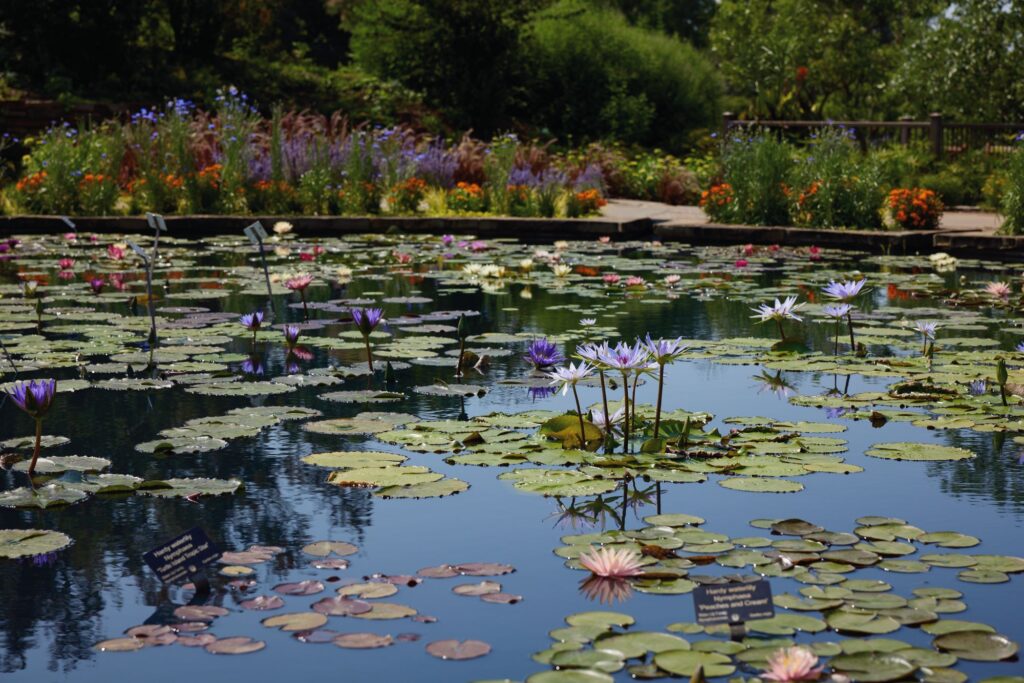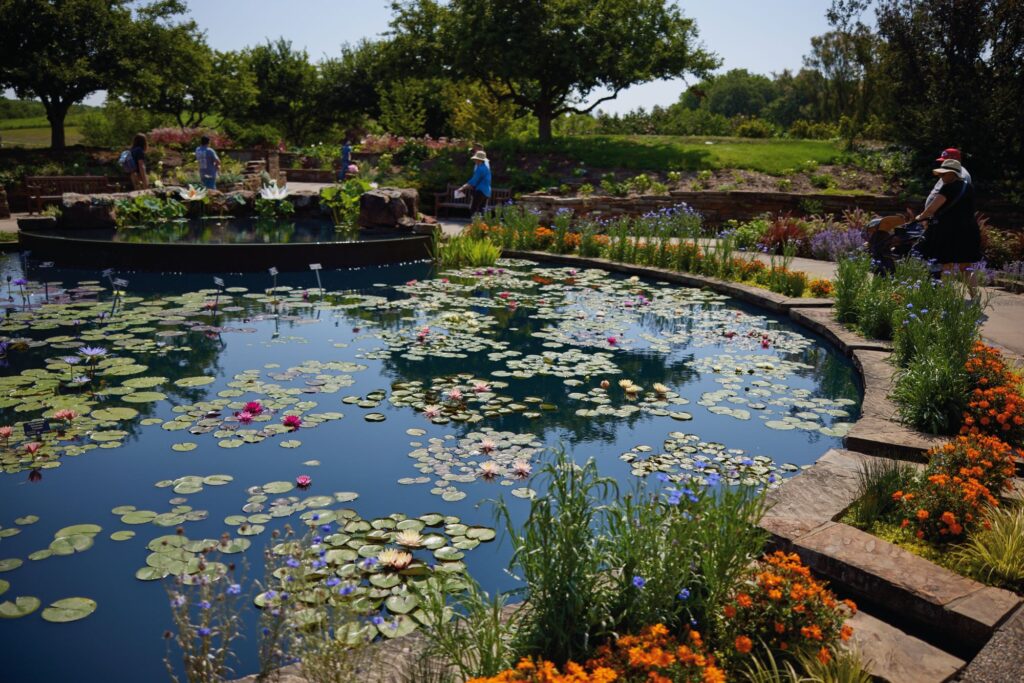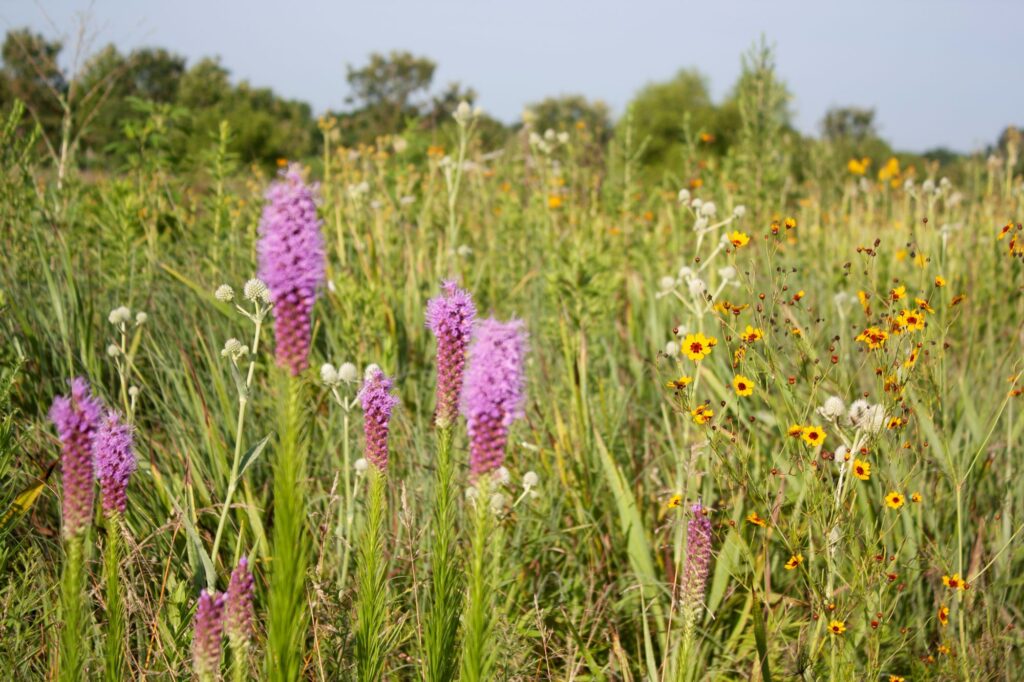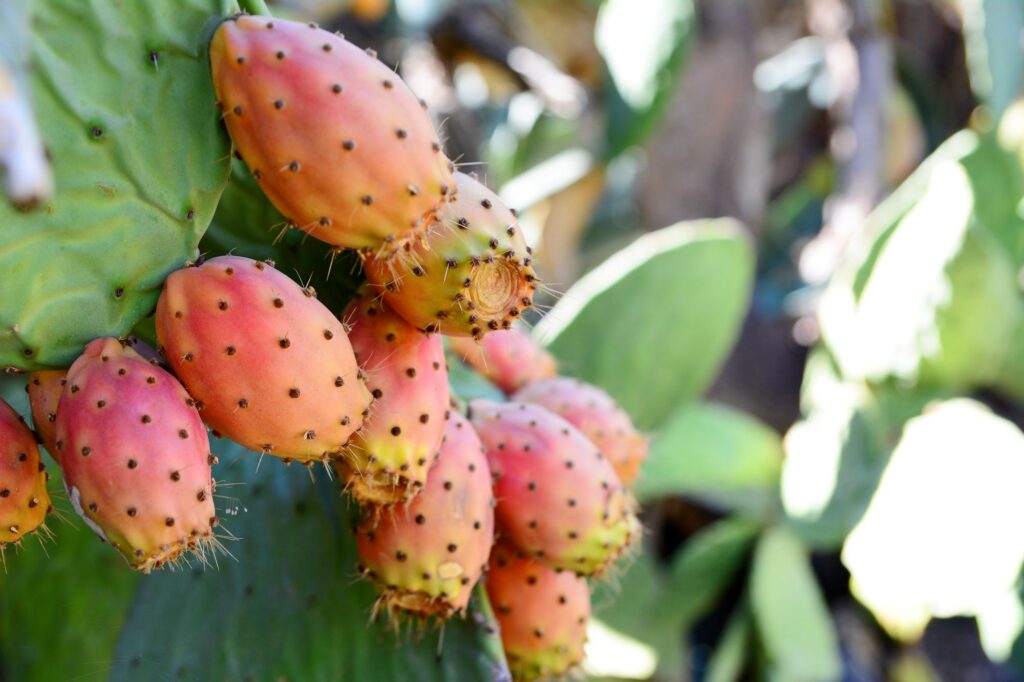
Nestled amidst the rolling hills and serene Midwest landscape, Powell Gardens houses an extensive collection of aquatic plants. The waterlily and lotus collections are certified collections of merit by the International Waterlily and Water Gardening Society.
The Marlese Lowe Gourley Island Garden stands out as a tranquil oasis, showcasing the mesmerizing beauty of waterlilies and lotuses. These aquatic wonders enhance this garden’s aesthetic appeal and play a role in maintaining the ecological balance of their watery habitats.

Waterlily vs. Lotus: Understanding the Differences
While waterlilies and lotuses both thrive in aquatic environments and share some visual similarities, they are distinct plants with unique characteristics. Understanding these differences can enhance your appreciation for these botanical wonders when visiting Powell Gardens.
Waterlily
- Belong to the genus Nymphaea, which includes various species found in tropical and temperate regions. They are part of the family Nymphaeaceae.
- Characterized by their broad, round leaves that float on the water’s surface. Their flowers also float on or just above the water’s surface, supported by flexible stems. Waterlily leaves typically have a notch from the edge to the center.
- Waterlily flowers come in a wide range of colors, including white, pink, red, yellow, blue, and purple. They are known for their symmetrical petals and can be either day-blooming or night-blooming, depending on the species.
Lotus
- Belong to the genus Nelumbo. They are part of the family Nelumbonaceae.
- Lotuses have a more upright growth habit. Their leaves are large, round, and often rise well above the water on sturdy stems. The flowers, which are also elevated above the water, can grow quite tall, creating a striking vertical presence. Lotus leaves are typically unnotched and display a unique hydrophobic property, causing water to bead and roll off, keeping them clean.
- Lotus flowers are typically white, pink, or red. They are larger and more robust compared to waterlilies, with petals that often form a cup-like shape. Lotus flowers follow the sun, opening in the morning and closing in the afternoon.
Both waterlilies and lotuses offer visual splendor and ecological benefits. While they share some similarities, their differences in growth habits and flower structure make each unique. At Powell Gardens, you can explore the captivating beauty of both these plants in the Marlese Lowe Gourley Island Garden or in a lotus-filled pond along the one-mile Family Discovery Loop.
Waterlilies and Lotuses at Powell Gardens
Waterlilies
Waterlilies are perhaps the most iconic of all aquatic plants, with their broad, floating leaves and striking, often fragrant flowers. At Powell Gardens, visitors can witness a stunning array of waterlily varieties, including cultivars and species, each with its unique charm and color palette.
The waterlily family (Nymphaeaceae) includes several different genera including Nuphar, Victoria (giant water platters), Euryale, Barclaya, Ondinea and Nymphaea (tropical and hardy waterlilies). Hardy waterlilies, which can survive the colder climates, bloom in an array of colors from white and pink to red and yellow. Tropical waterlilies, on the other hand, often boast more vibrant colors and larger blooms, and some varieties even emit a sweet fragrance during the night.
Beyond their visual appeal, waterlilies are vital to their ecosystems. They provide shade and habitat for aquatic creatures, help stabilize the water temperature, and improve water quality by oxygenating the water and reducing algae growth. These functions make waterlilies an integral part of the aquatic environment at Powell Gardens.

Lotuses at Powell Gardens
While waterlilies captivate visitors with their floating elegance, lotuses (genus Nelumbo) impress with their stature and profound symbolism. Often associated with purity, rebirth, and spiritual enlightenment, lotuses hold a special place in many cultures around the world.
The sacred lotus, Nelumbo nucifera, is renowned for its large, exquisite flowers and broad, round leaves that rise above the water’s surface. This species, native to Asia, features blooms that range from white to pink, and occasionally even blue. The flowers open in the morning and close in the afternoon. Powell Gardens has cultivars derived from this species in its collection.
One of the most fascinating aspects of the lotus is its remarkable adaptability. The plant’s ability to thrive in murky, muddy waters without getting dirty symbolizes purity and resilience. This unique trait is due to the lotus leaf’s superhydrophobic properties, which cause water droplets to bead up and roll off, carrying away dirt and debris.
Like waterlilies, lotuses contribute significantly to their aquatic environments. Their large leaves provide shade, which helps regulate water temperature and reduce the growth of harmful algae. Additionally, their roots help stabilize the pond bed, preventing erosion and providing a habitat for various aquatic organisms.
Viewing Aquatic Plants at Powell Gardens
A visit to Powell Gardens’ Marlese Lowe Gourley Island Garden will reward visitors with waterlilies in full bloom, surrounded by the gentle hum of dragonflies and the soothing sounds of water. Take a step off the beaten path along the one-mile Family Discovery Loop where hikers will be rewarded with a mass lotus planting surrounded by three pond-side decks.
Peak Bloom for Aquatic Plants
Peak blooming season for waterlilies is August – September and peak bloom for lotuses is during the warmer months of July-August. The early summer months are ideal for seeing the full splendor of the waterlilies, while late summer into early autumn is perfect for admiring the majestic lotuses.
Growing Aquatic Plants at Home
Many aquatic plants can be enjoyed at home! After setting up an aquarium or other space for the plants, home gardeners will need to maintain proper water conditions, provide adequate light, and fertilize regularly to ensure healthy growth. Provide a nutrient rich substrate to begin and start fertilizing with nutrient tablets or liquid fertilizer once plants are established.
Beginners should start with hardy, low-maintenance plants like Echinodorus (Amazon sword), Anubias, Egeria denus (anacharis), and Vallisneria spiralis ‘Corkscrew’. Make sure to keep plants and their tank environment clean. Monitoring water quality and ensuring a balanced ecosystem are key to sustaining vibrant aquatic plant life.
Wide, low sided containers or tubs can make great mini ponds. There are small waterlilies (such as ‘Chrysantha’) which would are suitable. Many plants grown in aquariums would transfer into this setup including Ludwigia repens, Bacopa caroliniana, Azolla, or Limnobium laevigatum (Amazon frogbit). A small sponge filter would allow for small fish to be added, reducing insect pests during the season. Make sure to change the water regularly!
Waterlily Wonders at Powell Gardens
Powell Gardens will celebrate Waterlily Wonders (August 6-18) this summer! These stunning blooms of lotus, waterlilies, and carnivorous plants, with their vibrant colors and unique structures, will be on display at Powell Gardens during their peak season. The lotus and waterlily collections have been designated as Certified Collections of Merit by the International Waterlily and Water Gardening Society.
During Waterlily Wonders, visitors can embark on guided tours (August 9 and 16 at 10 a.m.) or take a self-guided digital tour via Garden Explorer. For a serene and immersive experience, stroll through the Marlese Lowe Gourley Island Garden to see a mesmerizing display of aquatic plants in their natural habitat. Adventurers should look for carnivorous plants in the Marlese Lowe Gourley Island Garden and hike the one-mile Family Discovery Loop to see Powell Gardens’ natural lotus pond.
Plan Your Visit
Whether you are a plant enthusiast, a nature lover, or simply seeking a peaceful retreat, the aquatic collections at Powell Gardens offer a beautiful and enriching experience. Don’t miss the chance to witness the captivating beauty of waterlilies and lotuses at Kansas City’s botanical garden. Plan your visit today!
Related Posts


